How to Make Communication Boards:
Communication boards are a great, inexpensive way to provide someone with a means to communicate who may not be able to speak yet. Each board contains several pictures that represent different message that the person may want to say. The person using the board will then point to what he or she wants.
There is no right or wrong way to make a communication board. All you need is some pictures that represent basic words or thoughts that a person might want to communicate. You can grab our pre-made AAC Communication Boards inside The Hub or make your own by grabbing pictures from Google Image Search and copy/pasting them onto a word document.
Who Can Use Communication Boards?
Communication boards are used by children and adults who have a hard time speaking. This includes children with autism or apraxia as well as adults who have aphasia as a result of a stroke. Communication boards are easy and cheap to put together so they are a great option when you’re not sure what type of alternative communication method will be right for the person you’re working with.
How to Make an Inexpensive Communication Board from a Baking Sheet:
This video will teach you how to create a simple communication board from a cookie sheet, magnetic tape, and pictures. You will also learn how to use a communication board to help those who cannot speak, such as those with autism, apraxia, or aphasia.
Words to Include on Communication Boards
It’s important to include words on a communication board that can be used in a lot of different situations. We call these “Core Words”. For example, a word like “go” can be used to make a whole lot of different things go, or to indicate that the person themself wants to go somewhere. But the word “cookie” can really only be used to indicate that one very specific food. Instead, we could use a word like “eat” that would allow the person to communicate about a variety of foods.
Here are some great examples of Core Words to use on communication boards:
- I
- you
- want
- look
- my turn
- eat
- hurt
- where
- I like
- I don’t like
- drink
- bathroom
- what
- help
- no
- happy
- mad
- sad
- tired
- go
- stop
- more
- again
- leave
- all done
How Do I Teach Someone to Use Communication Boards?
You can teach someone to use a communication board by simply showing them how to do it. When you’re speaking to the child, point to some of the pictures as you talk. This will give the child a great model of how the board is meant to be used. For example, you can say “do you want a banana?” as you point to the banana picture, or even the “want” picture and then the “banana” picture.
For more information and help, check out my other post all about teaching a child to use a communication device or system:

About the Author: Carrie Clark, MA CCC-SLP
Hi, I’m Carrie! I’m a speech-language pathologist from Columbia, Missouri, USA. I’ve worked with children and teenagers of all ages in schools, preschools, and even my own private practice. I love digging through the research on speech and language topics and breaking it down into step-by-step plans for my followers.
Connect with Me:

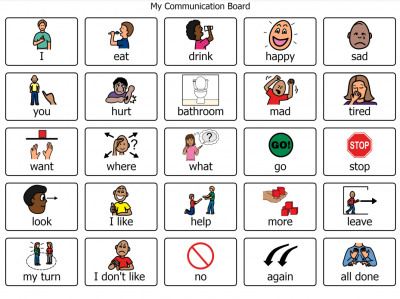
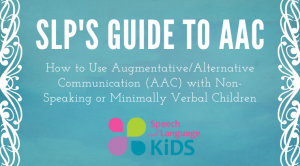
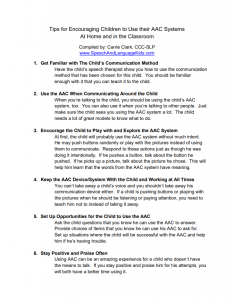
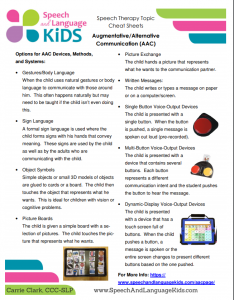
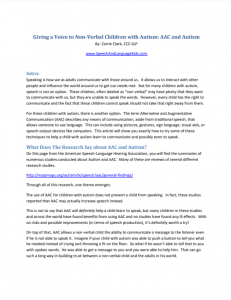





Use of communications are wonderful for apraxia. I have seen one boy that refused to use one or to use a communication device. His lack of communication was so frustrating for him because he wanted to verbally communicate and not show his thoughts.
It has taken kind and gentle handling to get the verbal to begin, which is now coming. Your idea of using something fun, like a cookie sheet is something I will try to use with him hoping that this will make it more relaxed and comfortable. He has a sense of humor. I have also found using the computer and creating documents and Power points he creates with me have been very successful. He shares his ideas this way with peers and the backup of the picture cues, which helps them understand. They in turn add to his ideas and they build a conversation together. Thanks for your ideas.
I will share your idea of the cookie sheet and maybe they can add with other fun ideas. I know we have some very nonverbal kids coming in the Fall that choose not to respond due to behavior and apraxia issues. Thanks you Mary
That sounds great! I’m so glad this idea will help some of your kiddos. It can be so frustrating for these little guys when they’re unable to communicate the thoughts that are in their heads! Good luck and thanks for reading!
How might one of these work with an Alzheimer’s patient? My wife has lost most of her expressive language really struggles to make her needs known. My fear is that she will not be able to learn how to use the board, as she forgets what she hears very quickly.
Thank you so much for posting this video. I am really excited to try it out with one of my young clients with down syndrome who is often unintelligible and has limited expressive language.
In Swedish we have a Word for when pointing at Pictures and talking at the same time (we use this term when introducing this to parents and patients) . In translation it’s something like “pointtalk”. Do you have a Word for this in English? As a SLP I’d like to know, for when searching the web and finding information about this or even for our English speaking patients and families.
/Fernanda
Thank you for making this video. This is exactly what I was looking for! My daughter had a stroke when she was a day old in the speech and language area. I’m so happy I found this. I’m going to share this page with KISS Kids & Infant Stroke Support.
You are more than welcome, Amanda! I’m glad our resources could be of help to you and we LOVE the sharing!